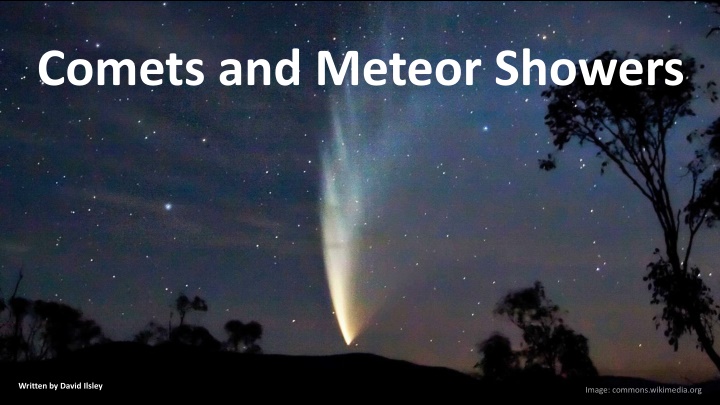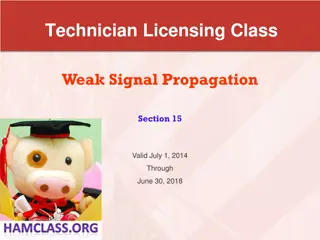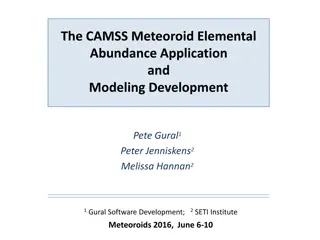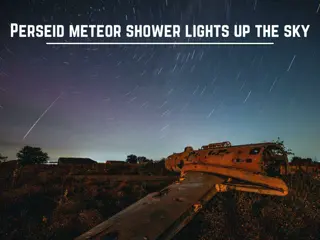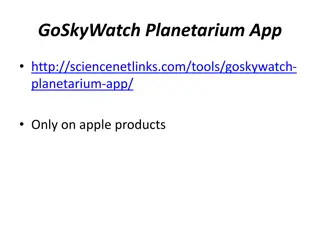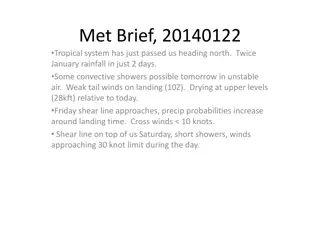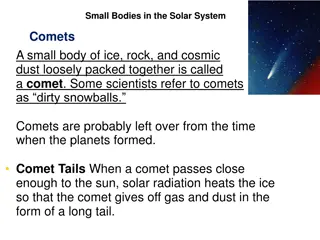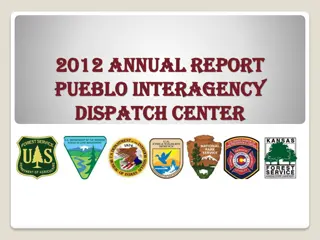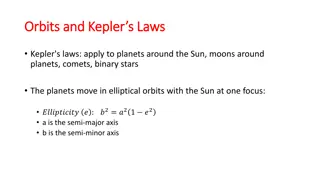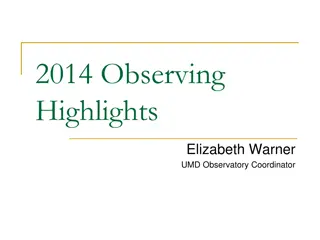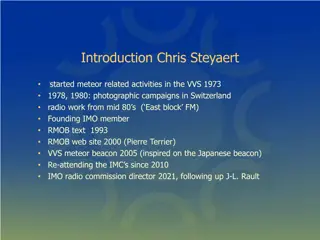Comets and Meteor Showers
This informative article delves into the fascinating world of comets, from their icy origins to their various locations in the solar system, including the Kuiper Belt and Oort Clouds. Discover the different types of comets, their composition, and the vast distances they travel as they orbit the Sun. Gain insights into the Inner and Outer Oort Clouds, shaped like a doughnut and a spherical shell, respectively, as they extend far beyond Pluto. Delve into the mysteries of these celestial bodies and their significance in understanding the cosmos.
Download Presentation

Please find below an Image/Link to download the presentation.
The content on the website is provided AS IS for your information and personal use only. It may not be sold, licensed, or shared on other websites without obtaining consent from the author.If you encounter any issues during the download, it is possible that the publisher has removed the file from their server.
You are allowed to download the files provided on this website for personal or commercial use, subject to the condition that they are used lawfully. All files are the property of their respective owners.
The content on the website is provided AS IS for your information and personal use only. It may not be sold, licensed, or shared on other websites without obtaining consent from the author.
E N D
Presentation Transcript
Comets and Meteor Showers Written by David Ilsley Image: commons.wikimedia.org
The word comet comes from the Latin word coma meaning hair. This is because they tend to look a bit like hair. Image: flickr.com
Comets originate as lumps of ice (mostly water but also methane, ethane, ammonia, carbon dioxide, carbon monoxide, hydrogen cyanide etc.) with lesser dust and rock particles (silicate and iron). They are sometimes called dirty snowballs . They are usually a few hundred metres to a few kilometres across. Image: en.wikiversity.org
The solar system is thought to have billions or even trillions of such dirty snowballs orbiting the Sun. Any inside the orbit of Jupiter would have long ago been evaporated by the radiation from the Sun. But there are many further out in a number of different zones. Image: flickr.com
Those between Jupiter and Neptune are called centaurs and orbit in fairly circular orbits in the same plane as the planets (the ecliptic). Another lot form the Kuiper Belt just beyond Neptune (30-50 AU from the Sun) along with larger bodies like Pluto. Their orbits are more irregular, many being quite eccentric or quite inclined to the plane of the planets. There are more in the Scattered Belt which goes out to 100 to 200 AU, with orbits even more irregular than the Kuiper Belt. Like the Kuiper Belt, this also contains larger objects like the dwarf planet Sedna. Finally there are the Inner Oort Cloud and the Outer Oort Cloud which seem to consist almost entirely of dirty snowballs. Image: commons.wikimedia.org
The Inner Oort Cloud (also called the Hills Cloud) is shaped like a doughnut 2 000 to 20 000 AU from the Sun, oriented broadly in the same plane as the planets. The Outer Oort Cloud is a spherical shell completely surrounding the rest of the solar system and ranging from about 20 000 to 100 000 AU from the Sun. The orbits of the Outer Oort Cloud objects would be in completely random directions. Image: commons.wikimedia.org
100 000 AU is more than a light year (1 ly 60 000 AU). As the nearest other stars are only about 4 light years away, the Outer Oort Clous stretches close to half way there. If other stars have similar Oort Clouds, then the clouds would almost touch. As stars are all in relative motion and other stars often pass within a light year of the Sun, their Oort clouds would pass through each other and their orbits would be disturbed by the gravity of the passing star. Image: commons.wikimedia.org
The dirty snowballs are thought to be left-overs from the cloud of gas and dust from which the planets etc. formed. There are thought to be billions or even trillions of them in the outer reaches of the solar system, though, being spread out over such a vast area, they tend to be a long way apart. In the inner solar system, collisions between the gas and dust particles caused them to collect into an accretion disc. Further out, because the material would have been more scattered and slower moving, collisions would have been much rarer. Thus they may not have collected into an accretion disc like the denser material closer to the Sun. Hence the random orbits.
The vast majority of these dirty snowballs stay in the outer reaches of the solar system. But, occasionally, some are disturbed by the gravity of a heavy object passing close by. Such objects might be a planet like Neptune, a dwarf planet like Pluto, another unknown object further out, or even a passing star or some other body from outside our solar system, like a rogue planet. When they are disturbed, they are deflected into a different orbit and sometimes the new orbit might bring them into the inner solar system. Image: commons.wikimedia.org
Snowballs in the outer solar system, being so small and so far away, are difficult to spot. Some centaurs have been seen from Earth, but no Oort Cloud Object has ever been seen. We only know they are there because some get deflected to where we can see them and we can extrapolate their orbits back to see were they came from. Image: commons.wikimedia.org
Actually, even in the inner part of the solar system, these snowballs would be difficult to spot except that they tend to put on a display. When they get closer than about Jupiter, the radiation from the Sun starts to warm them up and the ice starts to vaporise. This releases some of the dust and the comet becomes surrounded by a cloud of gas and dust. The solid part of the comet is then called the nucleus and the cloud is called the coma. While the nucleus is rarely more than a few kilometres in diameter, the coma can be thousands or even millions of kilometres across. Image: flickr.com
The most characteristic feature of a comet is its tail. This is produced by the solar wind pushing the gas and dust in the coma away from the Sun. There are commonly two tails. This can be seen in the picture. The bright white tail is the dust and the blue tail is ionised gas. The gas tail tends to point directly away from the Sun, but the dust tail tends to drag back because the dust particles move more slowly and are slowed down further by collisions with inter- planetary gas and dust. Image: commons.wikimedia.org
A comet gets close enough to be visible from Earth with the naked eye once every two or three years on average. Recent naked-eye comets include: Leonard Neowise Holmes McNaught January 2007 Hale-Bopp April 1997 Hyakutake March 1996 Halley s March 1986 December 2021 July 2020 December 2007
None of these, however, has been bright or large enough that you would notice it if you weren t looking for it. Such comets have occurred though. Comet Sarabat in 1729 reached a magnitude of 3, brighter than any star and about the brightness of Venus. Image: commons.wikimedia.org
In past times before the Enlightenment of the 17th Century, comets were seen by many cultures as omens (usually bad ones), messengers of the gods and harbingers of doom, and they were blamed for disasters that happened after their sighting. In England Halley s comet was blamed for bringing the Black Death, and the Incas in South America recorded a comet as foreshadowing Pizarro s arrival and the subsequent slaughter of their people. Image: commons.wikimedia.org Pope Calixtus III excommunicated Halley s Comet as an instrument of the devil.
Comets that come into the inner solar system generally have elliptical orbits with high eccentricities, meaning that the ellipses are very long and thin. Ones from the Oort cloud have orbits which are extremely long ellipses and thus they have very long periods, generally thousands or millions of years. Those from the region of the outer planets and the Kuiper Belt and Scattered disc have shorter obits and thus shorter periods. Halley s comet has a period of 75 years. This means that it reappears every 75 years. The last time was in 1986; the next will be 2061. The first recorded sighting was in 240 BCE. Comets with periods less than 200 years are called short-period comets.
The shape of a comets orbit can be determined by observation of its movement across the sky. This tells us how far away it came from. It is this information which tells us that there are a large number of snowballs between 2000 and 100 000 AU away forming the Oort Clouds. Comets from outside the solar system would have hyperbolic orbits (eccentricity > 1), though no comets have ever been observed to have a definitely hyperbolic orbit.
In general, comets will eventually return. Unless of course their orbit is perturbed by going too close to some large object like a planet. Comet Shoemaker-Levy 9 actually ran into Jupiter in July 1994. It had broken up a couple of years earlier and so impacted as a number of smaller pieces. The impact of one of the pieces is shown below in infra-red. The impact was actually around the back, but the bright spot came into view (bottom left) as Jupiter rotated. The bright spot to the right is Io. Image: en.wikipedia.org
The brown spots in this image are the after-effects of the impacts of the various fragments of the comet. Image: en.wikipedia.org
Comets would occasionally hit the Earth. Because they are lighter than asteroids and generally break up more easily, they would tend not to do as much damage as a similar-sized asteroid especially an iron one. However, as the largest comets can be over 100 km across (compared to 10 km for the asteroid that wiped out the dinosaurs), there is the potential for disaster. Image: stockvault.net
A comet that keeps coming into the inner solar system will lose some of its material each time. Eventually it will break up and/or completely evaporate leaving just a trail of dust and rock particles marking its orbit. Image: en.wikipedia.org Image: commons.wikimedia.org
This trail may last for thousands of years before dispersing. If the Earth s orbit passes through this trail, then many of the particles will strike the Earth s atmosphere producing a meteor shower. Such meteor showers recur each year as the Earth again passes through the dust trail. The Earth currently gets about 30 annual meteor showers. Of these, though, only about a dozen have a decent number of meteors.
In each shower, the meteors appear to come from a particular point in the sky, as determined by the direction the dust is coming from in the frame of reference of the Earth. Image: dailymail.co.uk They appear to spread out from that point the way rain drops seem to if you look into the direction the rain is coming from out of the front window of a car.
The point in the sky the meteors of a shower come from is called the radiant (because they radiate from that point). Each meteor shower is named after the constellation in which the radiant lies. The shower that has its radiant in Leo is called the Leonids. Image: dailymail.co.uk
These are the main meteor showers with their peak dates. Most showers last about 4 or 5 days, peaking in the middle of the date range. Typical numbers of meteors at peak are given in the table, though they do tend to vary from year to year. The numbers are in addition to the 5-10 per hour that come from random directions all the time. Image: en.wikipedia.org Image: en.wikipedia.org
Note that the Leonids generally number about 15 per hour at peak. But about every 33 years they become a meteor storm with thousands per hour. This has happened in 1767, 1799, 1833, 1866, 1867, 1966 and 1999. The storms occur because at one point in the dust trail there is a strong concentration of dust, probably caused by the comet undergoing a major disintegration at that point. This is a painting of the 1833 Leonid storm, though it is most likely an exaggeration. Image: flickr.com
In general, all else being equal, the higher the radiant is in the sky, the more meteors will be seen. The meteoroids arriving around the grey spot are spread over a larger area of atmosphere than those arriving around the white spot. None arrive at the black spot where the radiant is below the horizon. Earth Also those hitting at the white spot enter the atmosphere near vertically and so come down close to the ground. Those hitting at the grey spot just skim through the upper atmosphere where they are harder to see because they are further away.
The height of the radiant at different times can be found using Stellarium or similar programs.
The Other Type of Comet Image: openclipart.org Image: en.wikipedia.org
